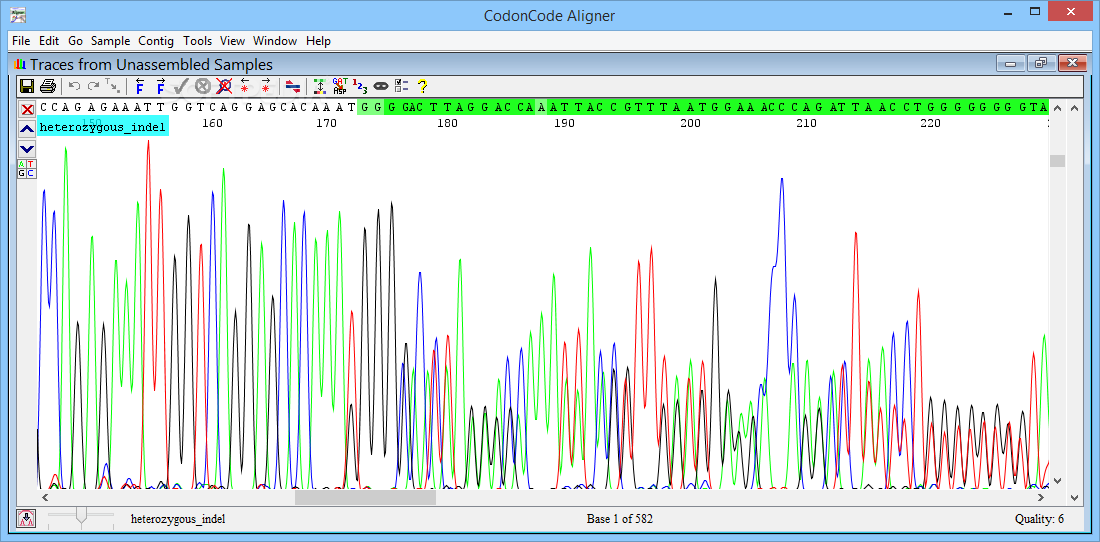Educators who would like to use CodonCode Aligner in bioinformatics, genetics, molecular systematics, or similar university classes can apply for free temporary teaching licenses. Teaching licenses are generally intended for small, specialized classes, and for relatively short periods of time where CodonCode Aligner would be needed in class (e.g. 4-6 weeks).
All things considered, CodonCode Aligner is a valuable tool for anyone involved in DNA sequencing and analysis. From simple sequence editing or trimming to complex mapping and phylogenetic tree. CodonCode Aligner 9 introduces a new base view that displays features and restriction enzyme cut sites. Clicking on a feature will select the features and the bases that it covers.
For contig editing on Windows (and Mac OS X), CodonCode Aligneris available and compatible with Phred-Phrap. Academic users can obtain Consed for restricted academic use free of charge directly from the University of Washington. For details, please visit http://www.phrap.org/consed/consed.html#howToGet. CodonCode Aligner is a leading software program for DNA sequence assembly, alignment, contig editing, and mutation detection. In addition to features common in sequence assembly programs like end clipping, alignments to reference sequences, and exporting, CodonCode Aligner offers many unique features not found in other software. CodonCode Aligner 6.0.2:: DESCRIPTION. CodonCode Aligner is a program for sequence assembly, contig editing, and mutation detection, available for Windows and Mac OS X. Aligner is compatible with Phred-Phrap and fully supports sequence quality scores, while offering a familiar, easy-to-learn user interface.
Classroom use of CodonCode Aligner is simplified through the Aligner License Server. Instructors set up a single computer on which the Aligner License Server is installed, and enter a license key that allows concurrent use by all students and teaching assistants. License keys can are typically made available for only the weeks where CodonCode Aligner is needed.

Typically, at least one of the class instructors is already a CodonCode Aligner user, although this is not a requirement.
To apply for temporary teaching licenses, instructors should contact CodonCode Corporation by email and include the following information:
- Name and university email address of the instructor
- Course description
- Duration of the course
- Number of students
- Start and end dates of the course
- Dates when CodonCode Aligner will be needed for course
- Description of how CodonCode Aligner will be used in course
- Web links to the course syllabus, if available; otherwise, PDF documents or short descriptions

Instructors should also indicate how familiar they are with CodonCode Aligner, and if they own or have access to purchased licenses. Free teaching licenses are granted solely at CodonCode Corporation's discretion, and may not be granted to all applicants.
Classes That Used CodonCode Aligner
Here are some courses where CodonCode Aligner has been used:
Codencode
- Building technical expertise to enhance species detection for invasive alien species, pests, wildlife trade and biodiversity management
Anton de Kom University of Suriname, Paramaribo, Suriname
Instructor: Vanessa Kadosoe - General Biology Laboratory II (BIOL 112)
Loyola Marymount University, Los Angeles, CA, USA
Instructor: Tatiana Kuzmenko - DNA Barcoding & Sequence Analyses Workshop
Pibulsongkram Rajabhat University, Mueang, Thailand
Instructor: Asst. Prof. Dr. Pisit Poolprasert - Plant Biotechnology
University of Saint Etienne, France
Instructor: Jean-Louis Magnard - Special Subject Pathology
University of Cambridge, UK
Instructor: Dr. Elizabeth Soilleux - Principles of Genetics (GEN371)
West Virginia University, Morgantown, WV, USA
Instructor: Teiya Kijimoto - Genetics and Genomics
Vassar College, Poughkeepsie, NY, USA
Instructor: Barbara Holloway - Laboratory Methods in Molecular Biology
University of New Mexico, Albuquerque, NM, USA
Instructor: Coen M Adema - Molecular Genetics and Ecology
University of Malaya, Kuala Lumpur, Malaysia
Instructor: Dr. John James Wilson - Biology 107
Mesa Community College, Mesa, AZ, USA
Instructor: Dr. Andrew S. Baldwin - Introduction to Bioinformatics
Fort Hays State University, Hays, KS, USA
Instructor: Dr. Sam R. Zwenger - General Biology
State University of New York, Potsdam, NY, USA
Instructor: Dr. Robert Snyder - Evolutionary genetics
University of Primorska, Koper, Slovenia
Instructor: Martina Luznik / Ziva Fiser Pecnikar / Sara Zupan - Lab in Molecular Biology (BC3303)
Barnard College, New York, NY, USA
Instructor: Jennifer Mansfield - Basic AgroMicrobiology,
Gut Biology and Health
Aarhus University, Tjele, Denmark
Instructor: Dr. Ole Højberg - Molecular Ecology and Evolution (BIOL 4301/6301)
Texas Tech University, Lubbock, Texas, USA
Instructor: Dr. Matt Olson - Applied Genetics and Biotechnology (Biol 425)
University of Northern British Columbia, Prince George, BC, Canada
Instructor: Dr. Brent Murray - Computer Lab in Molecular Systematics (Biology 402)
California State University, Fullerton, CA, USA
Instructor: Prof. Dr. Douglas Eernisse - Advanced Genetics and Genomics (BI392)
Colby College, Waterville, Maine, USA
Instructor: Prof. Dr. Josh Kavaler - Molecular Phylogenetics (GE15)
Technical University Braunschweig, Germany
Instructors: Prof. Dr. Miguel Vences and Dr. Susanne Hauswaldt - Molecular Biology for Marine Sciences (Biol457/557)
OIMB, University of Oregon, Charleston, Oregon, USA
Instructor: Prof. Dr. Svetlana Maslakova - Medical Biomedicine
Veterinary institute, Techincal University of Denmark, Denmark
Instructor: Martin Weiss Nielsen
